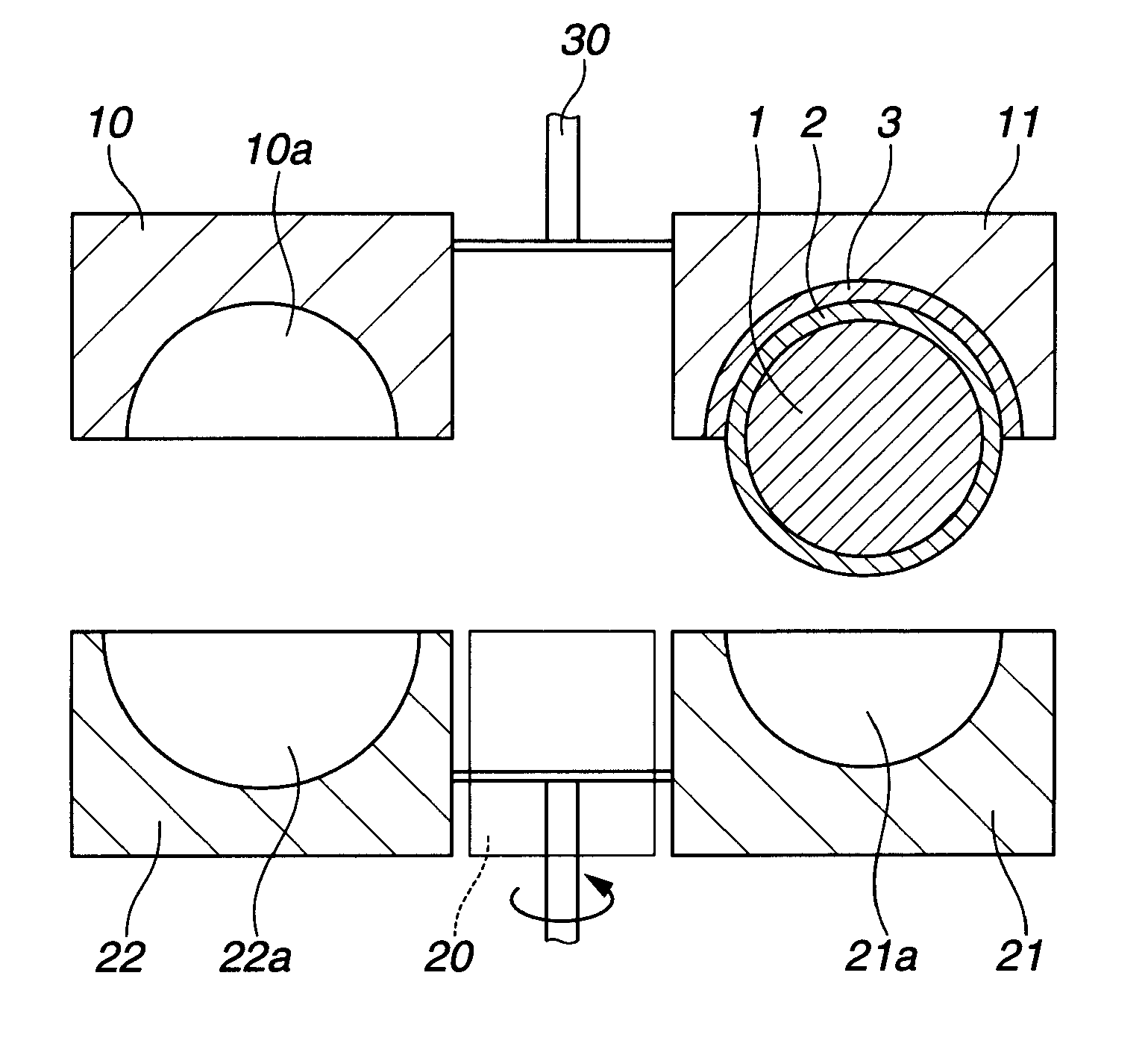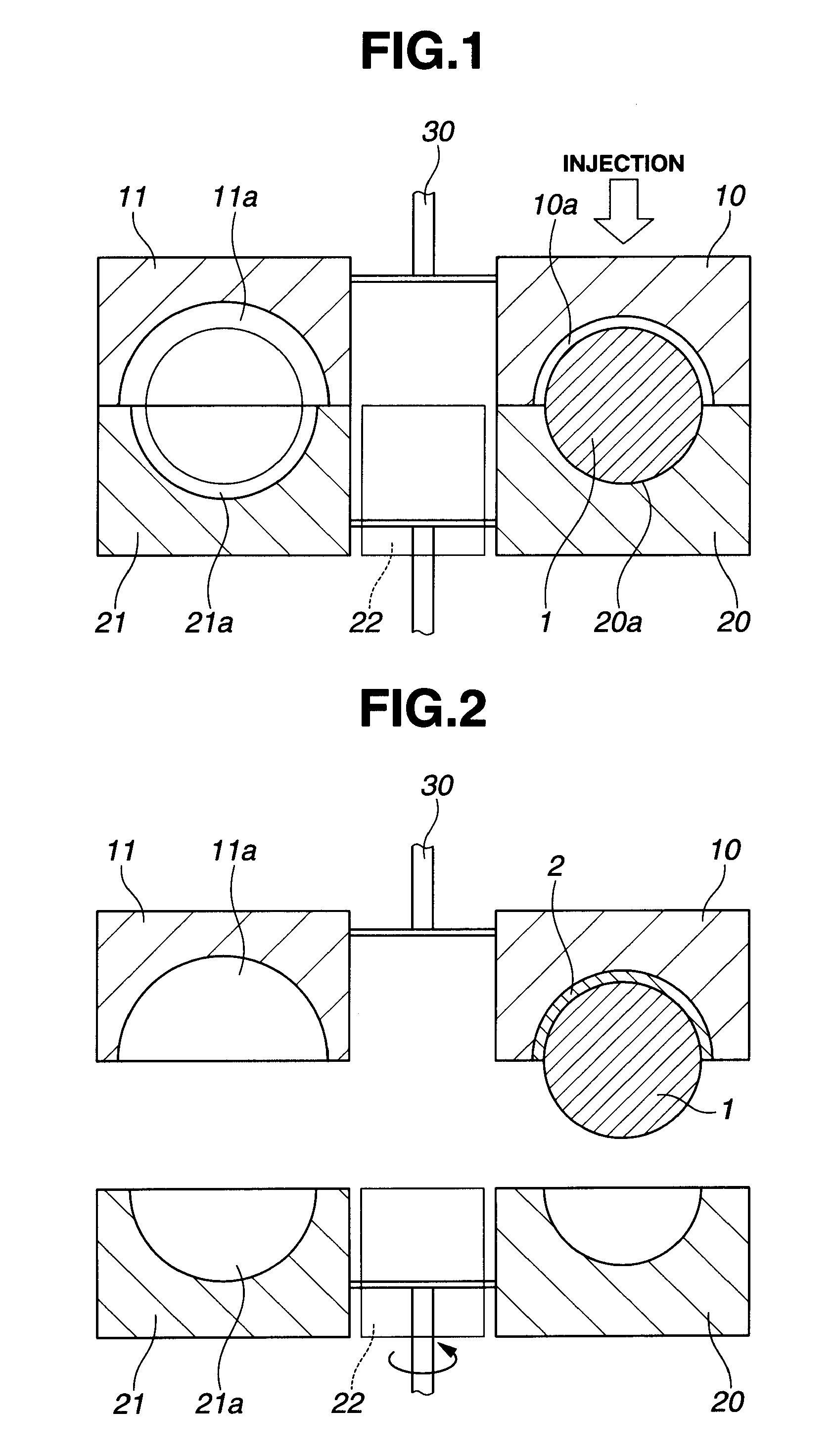Method of manufacturing a golf ball
a manufacturing method and golf ball technology, applied in the field of golf ball manufacturing methods, can solve the problems of sphere eccentricity, loss of strength of bond between the surface of the sphere and the overlying cover, and weakening of the bonding area between the surfaces of the sphere, so as to achieve excellent durability and other properties
Inactive Publication Date: 2008-12-04
BRIDGESTONE SPORTS
View PDF11 Cites 8 Cited by
- Summary
- Abstract
- Description
- Claims
- Application Information
AI Technical Summary
Benefits of technology
The present invention provides a golf ball manufacturing method that can produce high-quality golf balls with excellent durability and other properties. The method involves using at least two vertically separating two-part molds of differing size cavities, each mold being composed of a top half and a bottom half, to consecutively form at least a first covering layer and a second covering layer around a core or sphere. The method includes steps of placing the core or sphere in the molds, injection-molding a molding material to form the first covering layer, rotating the molds to a predetermined position, placing the core or sphere in the second mold, and injection-molding a molding material to form the second covering layer. The method avoids the need for transferring the core or sphere from one mold to another mold before injection-molding thereon a cover material, which improves the durability of the golf ball.
Problems solved by technology
In the manufacturing method described above, because the sphere is supported inside the mold cavity with support pins, sphere eccentricity tends to arise.
However, in these prior-art golf ball manufacturing methods, forming two or more cover layers over a core or an inner layer of rubber enclosed by an envelope layer requires the use of two or more different molds having cavities that correspond to the cover layer thicknesses.
As a result, when the molded sphere is transferred from one mold to another mold and a cover material is injection-molded thereon, dust and debris tend to adhere to the surface of the sphere, sometimes resulting in a loss in the strength of the bond between the surface of the sphere and the overlying cover.
Moreover, because the component sections are separately fabricated, the adherence of dust and debris weakens the strength of bonded areas therebetween.
Method used
the structure of the environmentally friendly knitted fabric provided by the present invention; figure 2 Flow chart of the yarn wrapping machine for environmentally friendly knitted fabrics and storage devices; image 3 Is the parameter map of the yarn covering machine
View moreImage
Smart Image Click on the blue labels to locate them in the text.
Smart ImageViewing Examples
Examples
Experimental program
Comparison scheme
Effect test
example 1
[0051]Using the above-described golf ball molds of FIGS. 1 to 7, a first covering layer and a second covering layer were created by methods similar to those described in conjunction with FIGS. 1 to 7.
the structure of the environmentally friendly knitted fabric provided by the present invention; figure 2 Flow chart of the yarn wrapping machine for environmentally friendly knitted fabrics and storage devices; image 3 Is the parameter map of the yarn covering machine
Login to View More PUM
| Property | Measurement | Unit |
|---|---|---|
| diameter | aaaaa | aaaaa |
| diameter | aaaaa | aaaaa |
| diameter | aaaaa | aaaaa |
Login to View More
Abstract
The present invention provides a method of manufacturing a golf ball having a core or a sphere composed of a core enclosed by an envelope layer over which core or sphere at least a first covering layer and a second covering layer are consecutively formed using at least two vertically separating two-part molds of differing size cavities, each mold being composed of a top half and a bottom half, that are installed in such a way that the top mold halves are horizontally rotatable together and the bottom mold halves are horizontally rotatable together. The method includes the steps of: (1) placing the core or sphere in the cavities of a first top mold half and a first bottom mold half and injection-molding a molding material so as to form the first covering layer over the core or sphere one hemisphere at a time; and (2) rotating a second top mold half or second bottom mold half having a cavity that is larger than the cavity of the first top mold half or first bottom mold half to a predetermined position, placing the core or sphere on which has been formed the first covering layer in the second top mold half or second bottom mold half, and injection-molding a molding material so as to form the second covering layer around the first covering layer one hemisphere at a time. By molding the covering layers one hemisphere at a time, two or more covering layers of differing thickness can be consecutively formed. Golf balls obtained in this way are of higher quality than conventionally manufactured balls and can be endowed, in particular, with an improved durability.
Description
BACKGROUND OF THE INVENTION[0001]The present invention relates to a method of manufacturing a golf ball having an inner sphere composed of a core and one or more envelope layer enclosing the core, and having a cover which encloses the inner sphere. More specifically, the invention relates to a method of manufacturing a golf ball which includes injection molding the inner sphere, then, without completely releasing the spherical material from the mold, successively molding the cover.[0002]Generally, to mold a golf ball core, unvulcanized rubber is formed into a slug of a fixed weight by way of an extrusion step. The slug is then inserted into a vulcanizing mold, where it is subjected to vulcanization under pressure, thereby giving a core made of a rubber material in the form of a sphere. To produce via pressure vulcanization a rubber sphere of two or more layers, an envelope layer-enclosed rubber sphere can be obtained by injection-molding one envelope layer about the core while holdi...
Claims
the structure of the environmentally friendly knitted fabric provided by the present invention; figure 2 Flow chart of the yarn wrapping machine for environmentally friendly knitted fabrics and storage devices; image 3 Is the parameter map of the yarn covering machine
Login to View More Application Information
Patent Timeline
 Login to View More
Login to View More Patent Type & Authority Applications(United States)
IPC IPC(8): B28B5/08B28B1/28
CPCB29C45/0441B29C45/14819B29C45/162B29C45/1671B29L2031/54
Inventor WACHI, TOSHIRO
Owner BRIDGESTONE SPORTS
Features
- R&D
- Intellectual Property
- Life Sciences
- Materials
- Tech Scout
Why Patsnap Eureka
- Unparalleled Data Quality
- Higher Quality Content
- 60% Fewer Hallucinations
Social media
Patsnap Eureka Blog
Learn More Browse by: Latest US Patents, China's latest patents, Technical Efficacy Thesaurus, Application Domain, Technology Topic, Popular Technical Reports.
© 2025 PatSnap. All rights reserved.Legal|Privacy policy|Modern Slavery Act Transparency Statement|Sitemap|About US| Contact US: help@patsnap.com



